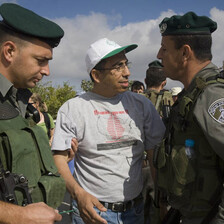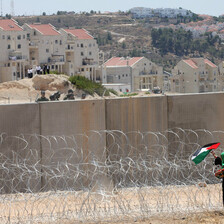The Electronic Intifada 11 May 2011
Intifada: a Palestinian uprising. National committees organizing popular resistance; boycotts and tax revolts against the occupier; mass demonstrations calling for an end to the occupation; a violent crackdown by the occupation forces — and an official Palestinian leadership caught off guard.
This may sound like a description of the first intifada of 1987-1991 but it’s also how the 1936-39 Palestinian revolt against British occupation operated. Mazin Qumsiyeh’s new book on the long history of Palestinian popular struggle, Popular Resistance in Palestine: a History of Hope and Empowerment is great for drawing out such parallels.
Qumsiyeh traces this vibrant history even further than the British Mandate, back to the days of Ottoman rule and uprisings against both the Turkish empire and the Egyptian occupation of the 1830s (36). Even readers familiar with the Great Revolt of the 1930s will find much to enlighten them here.
Qumsiyeh recounts the successes and failures, before the British occupation of Palestine in 1917, of Palestinian campaigns to resist dispossession of fellahin (peasant farmers) by Zionist land colonization organizations and militias (working in cooperation with the Ottoman state) (39-47).
A zoologist from Beit Sahour near Bethlehem in the occupied West Bank, Qumsiyeh is also an activist, and takes a refreshingly practical approach to history. One of the book’s main strengths is that Qumsiyeh has a measured take on the issue of nonviolence verses violence. As he explains early on, he generally prefers the term “popular resistance” to “nonviolence” — mainly because that’s the term generally used in Palestine for this form of resistance (muqawama shabiya) (11).
As he notes, Palestinians do have the right to armed resistance in international law (21), and “there are no examples [in history] of completely nonviolent struggle for freedom from colonial occupation” (20). But Qumsiyeh advocates strongly for the practical and moral benefits of nonviolent strategies. He convincingly argues in his conclusion that “The only constant through the ups and downs of the political structures, and through the ebbs and flows of the armed resistance, was popular resistance” (238).
Neglected history
Qumsiyeh has an eye for the overlooked and the neglected; hence the reader learns about the printing of Arabic newspapers under Ottoman censorship (45), the 1913 establishment in Nablus of a society against Zionism (46), the sending of Palestinian delegates to the Ottoman parliament of 1908 (after the Young Turks’ coup) (43-44), and simply refusing to vacate land wanted by the colonizer “can be considered a form of nonviolent resistance” (29).
Overall the chapter on the Ottoman period is excellent and contains material that will be new to many readers. Unfortunately the biggest error in the book also comes in reference to this period. In the concluding chapter Qumsiyeh argues that armed resistance is actually a later development in the history of Palestinian resistance to Zionist colonization, and that “[f]or the first few decades (1880s-1920s) all resistance was popular and unarmed.”
In fact, as historian Rashid Khalidi has observed, fallahin resistance to land evictions by Ottoman authorities and Zionist militias took the form of both armed and unarmed resistance (Palestinian Identity: The Construction, of Modern National Consciousness, Columbia University Press, 1997; chapter 5). However, this is an uncharacteristic error and for the most part the book gives due recognition to different forms of resistance (while still focusing on the unarmed).
The book then continues with chapters tracing the history of popular resistance through the different phases of Palestinian history. In the post-Nakba period, for example, Qumsiyeh describes how many Palestinians attempted to return to their lands to harvest produce but were “shot on the spot” by Israeli forces, in the words of one British officer (98).
There is a strong section on the foundations of the first intifada recounting the neglected history of the events leading to its outbreak in 1987. Qumsiyeh takes an unorthodox line on the question of the how the intifada started (135-136). This is often ascribed to December rumors that an Israeli vehicle had deliberately run over several Palestinian workers, but here we learn (based on accounts in Palestinian newspaper Al-Quds) about a series of demonstrations that took place in Gaza and the West Bank in October and November.
Popular resistance today
Qumsiyeh brings the historical narrative right up to date with with a chapter each on the second intifada and the boycott, divestment and sanctions (BDS) movement.
The second intifada of 2000-2005 is thought to be characterized by armed resistance and violent attacks on Israeli civilians in contrast to the first intifada (which was almost entirely unarmed). However, it began as a popular uprising and only became militarized after Israel responded to the unarmed demonstrations of September-October with (according to an Israeli general) one million bullets in the first two weeks alone (169).
The BDS chapter contains a list of significant victories in the BDS campaign that, while still a handy reference, feels sketchy, almost as if it it were a first draft. Notwithstanding, both these chapters are still very good, and the BDS chapter includes an excellent outline (209-212) of the various different events and boycott statements that led to the landmark 2005 call for BDS signed by so many Palestinian civil society groups. The call has led to an explosion of victories in the campaign. There is also a good historical perspective on the history of boycotts in the Palestinian struggle (207-208).
Other criticisms of the book are worth making. In parts, Qumsiyeh does assume some prior knowledge of Palestinian history, so this might not be the best place to start for those entirely new to the topic.
There is also room to question some of Qumsiyeh’s historical interpretations. For example, on page 94 he claims (unconvincingly) that the UN plan to partition Palestine only passed in the General Assembly because of US President Harry Truman’s “need for Jewish backing in the [US] election.” A more likely explanation was the General Assembly’s inherent bias in 1947 towards the colonial powers — who, before the decolonization of the 1960s, were more in control of the UN.
But overall this book provides a vital, factual corrective to the tired old question often heard from western liberals: “where is the Palestinian Gandhi?”
Above all, it is a timely work. The revolutions and intifadas against dictatorial regimes in the Arab world that began in Tunisia, have very much been popular uprisings that have (with the exception of Libya) rejected the use of arms, while still at times using assertive self-defense tactics such as stone-throwing against armed police and regime thugs.
The history narrated here, and the many similarities and parallels it has with the tactics of current-day Arab revolutions, suggest that Arabs have learned much from the Palestinian experience. In turn, there’s no doubt that Tunisia, and particularly Egypt, have been an inspiration for the Palestinian popular struggle.
Mazin Qumsiyeh here provides us with an essential perspective: not that of a detached ivory tower academic, but that of a Palestinian active in resistance to the Israeli occupation, narrating the history of the struggle he was born into.
The next time someone bores you with that old canard about the “Palestinian Gandhi” I suggest telling them to either go away and read this book or forever hold their peace.
Asa Winstanley is a freelance journalist based in London who has lived in and reported from occupied Palestine. He is the editor of a book about the Russell Tribunal on Palestine coming out on Pluto Press later in 2011. His website is www.winstanleys.org.





